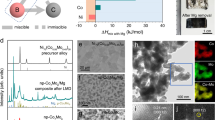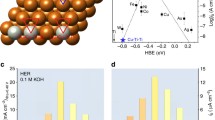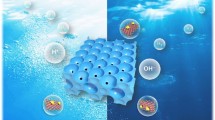Abstract
Nanoporous metals show promising performances in electrochemical catalysis. In this paper, we report a self-supporting bimetallic porous heterogeneous indium/copper structure synthesized with a eutectic gallium-indium (EGaIn) material on a copper substrate. This nanoporous copper-indium heterostructure catalyst exhibits excellent performance in the reduction of carbon dioxide to syngas. The ratio of H2/CO is tunable from 0.47 to 2.0 by changing working potentials. The catalyst is highly stable, showing 96% maintenance of the current density after a 70-h continuous test. Density functional theory calculations reveal that the indium/copper interface induces charge redistribution within the copper surface, leading to the formation of two distinct active sites, namely, Cuδ and Cu0, and enabling a high-performance generation of CO and H2. This work provides a new strategy for obtaining self-supporting nanoporous metal electrode catalysts.
摘要
纳米多孔金属作为电催化剂使用时表现出了优异的性能. 我们报道了一种利用共熔镓铟合金和铜基底制备而成的自支撑铜铟双金属多孔异质结构材料. 该多孔铜铟异质结构电催化剂具有良好的二氧化碳转化为合成气的性能. 通过调整工作电压, 可以使氢气和一氧化碳的比例控制在0.47–2.0之间. 且该催化剂非常稳定, 经过70小时连续测试后还可以保持96%的电流密度. 密度泛函理论计算表明, 得益于这种铜铟异质结构的存在, 铜表面电荷发生了转变, 形成了Cuδ和Cu0等不同位点, 从而协同作用分别增**了催化剂生成一氧化碳和氢气的能力. 本工作可为多孔金属异质结构电催化剂的设计提供新思路.
Similar content being viewed by others
References
Wittstock A, Zielasek V, Biener J, et al. Nanoporous gold catalysts for selective gas-phase oxidative coupling of methanol at low temperature. Science, 2010, 327: 319–322
Fujita T, Guan P, McKenna K, et al. Atomic origins of the high catalytic activity of nanoporous gold. Nat Mater, 2012, 11: 775–780
Lu Q, Hutchings GS, Yu W, et al. Highly porous non-precious bimetallic electrocatalysts for efficient hydrogen evolution. Nat Commun, 2015, 6: 6567
Zielasek V, Jürgens B, Schulz C, et al. Gold catalysts: Nanoporous gold foams. Angew Chem Int Ed, 2006, 45: 8241–8244
Lang X, Hirata A, Fujita T, et al. Nanoporous metal/oxide hybrid electrodes for electrochemical supercapacitors. Nat Nanotech, 2011, 6: 232–236
Han J, Lin YC, Chen L, et al. On-chip micro-pseudocapacitors for ultrahigh energy and power delivery. Adv Sci, 2015, 2: 1500067
Chen Q, Sieradzki K. Spontaneous evolution of bicontinuous nanostructures in dealloyed Li-based systems. Nat Mater, 2013, 12: 1102–1106
An Y, Tian Y, Wei C, et al. Dealloying: An effective method for scalable fabrication of 0D, 1D, 2D, 3D materials and its application in energy storage. Nano Today, 2021, 37: 101094
Wang Z, Liu P, Han J, et al. Engineering the internal surfaces of three-dimensional nanoporous catalysts by surfactant-modified dealloying. Nat Commun, 2017, 8: 1066
Snyder J, Asanithi P, Dalton AB, et al. Stabilized nanoporous metals by dealloying ternary alloy precursors. Adv Mater, 2008, 20: 4883–4886
Zhang W, Xu C, Hu Y, et al. Electronic and geometric structure engineering of bicontinuous porous Ag-Cu nanoarchitectures for realizing selectivity-tunable electrochemical CO2 reduction. Nano Energy, 2020, 73: 104796
Yao R, Lang X, Jiang Q. Recent advances of nanoporous metal-based catalyst: Synthesis, application and perspectives. J Iron Steel Res Int, 2019, 26: 779–795
Lu Z, Li C, Han J, et al. Three-dimensional bicontinuous nanoporous materials by vapor phase dealloying. Nat Commun, 2018, 9: 276
McCue I, Ryan S, Hemker K, et al. Size effects in the mechanical properties of bulk bicontinuous Ta/Cu nanocomposites made by liquid metal dealloying. Adv Eng Mater, 2016, 18: 46–50
Geslin PA, McCue I, Gaskey B, et al. Topology-generating interfacial pattern formation during liquid metal dealloying. Nat Commun, 2015, 6: 8887
Wada T, Geslin PA, Kato H. Preparation of hierarchical porous metals by two-step liquid metal dealloying. Scripta Mater, 2018, 142: 101–105
Ellis PR, Enache DI, James DW, et al. A robust and precious metal-free high performance cobalt Fischer-Tropsch catalyst. Nat Catal, 2019, 2: 623–631
AlNouss A, McKay G, Al-Ansari T. Production of syngas via gasification using optimum blends of biomass. J Clean Prod, 2020, 242: 118499
Hernández S, Amin Farkhondehfal M, Sastre F, et al. Syngas production from electrochemical reduction of CO2: Current status and prospective implementation. Green Chem, 2017, 19: 2326–2346
Leverett J, Daiyan R, Gong L, et al. Designing undercoordinated Ni-Nx and Fe-Nx on holey graphene for electrochemical CO2 conversion to syngas. ACS Nano, 2021, 15: 12006–12018
Daiyan R, Lovell EC, Huang B, et al. Uncovering atomic-scale stability and reactivity in engineered zinc oxide electrocatalysts for controllable syngas production. Adv Energy Mater, 2020, 10: 2001381
Daiyan R, Chen R, Kumar P, et al. Tunable syngas production through CO2 electroreduction on cobalt-carbon composite electrocatalyst. ACS Appl Mater Interfaces, 2020, 12: 9307–9315
Ross MB, Dinh CT, Li Y, et al. Tunable Cu enrichment enables designer syngas electrosynthesis from CO2. J Am Chem Soc, 2017, 139: 9359–9363
Kumar B, Brian JP, Atla V, et al. Controlling the product syngas H2:CO ratio through pulsed-bias electrochemical reduction of CO2 on copper. ACS Catal, 2016, 6: 4739–4745
Mascaretti L, Niorettini A, Bricchi BR, et al. Syngas evolution from CO2 electroreduction by porous Au nanostructures. ACS Appl Energy Mater, 2020, 3: 4658–4668
Lamaison S, Wakerley D, Montero D, et al. Zn-Cu alloy nanofoams as efficient catalysts for the reduction of CO2 to syngas mixtures with a potential-independent H2/CO ratio. ChemSusChem, 2019, 12: 511–517
Kim H, Lee H, Lim T, et al. Facile fabrication of porous Sn-based catalysts for electrochemical CO2 reduction to HCOOH and syngas. J Industrial Eng Chem, 2018, 66: 248–253
Ross MB, Li Y, De Luna P, et al. Electrocatalytic rate alignment enhances syngas generation. Joule, 2019, 3: 257–264
Li H, Wen P, Itanze DS, et al. Colloidal silver diphosphide (AgP2) nanocrystals as low overpotential catalysts for CO2 reduction to tunable syngas. Nat Commun, 2019, 10: 5724
Lee JH, Kattel S, Jiang Z, et al. Tuning the activity and selectivity of electroreduction of CO2 to synthesis gas using bimetallic catalysts. Nat Commun, 2019, 10: 3724
Lv K, Teng C, Shi M, et al. Hydrophobic and electronic properties of the E-MoS2 nanosheets induced by FAS for the CO2 electroreduction to syngas with a wide range of CO/H2 ratios. Adv Funct Mater, 2018, 28: 1802339
He R, Zhang A, Ding Y, et al. Achieving the widest range of syngas proportions at high current density over cadmium sulfoselenide nanorods in CO2 electroreduction. Adv Mater, 2018, 30: 1705872
**e Q, Larrazábal GO, Ma M, et al. Copper-indium hydroxides derived electrocatalysts with tunable compositions for electrochemical CO2 reduction. J Energy Chem, 2021, 63: 278–284
Liang Z, Song L, Sun M, et al. Tunable CO/H2 ratios of electrochemical reduction of CO2 through the Zn-Ln dual atomic catalysts. Sci Adv, 2021, 7: eabl4915
Zhong H, Ghorbani-Asl M, Ly KH, et al. Synergistic electroreduction of carbon dioxide to carbon monoxide on bimetallic layered conjugated metal-organic frameworks. Nat Commun, 2020, 11: 1409
Hoffman ZB, Gray TS, Moraveck KB, et al. Electrochemical reduction of carbon dioxide to syngas and formate at dendritic copper-indium electrocatalysts. ACS Catal, 2017, 7: 5381–5390
**ang H, Rasul S, Hou B, et al. Copper-indium binary catalyst on a gas diffusion electrode for high-performance CO2 electrochemical reduction with record CO production efficiency. ACS Appl Mater Interfaces, 2020, 12: 601–608
**e H, Chen S, Ma F, et al. Boosting tunable syngas formation via electrochemical CO2 reduction on Cu/In2O3 core/shell nanoparticles. ACS Appl Mater Interfaces, 2018, 10: 36996–37004
Daeneke T, Khoshmanesh K, Mahmood N, et al. Liquid metals: Fundamentals and applications in chemistry. Chem Soc Rev, 2018, 47: 4073–4111
Khoshmanesh K, Tang SY, Zhu JY, et al. Liquid metal enabled microfluidics. Lab Chip, 2017, 17: 974–993
Liu H, **a J, Zhang N, et al. Solid-liquid phase transition induced electrocatalytic switching from hydrogen evolution to highly selective CO2 reduction. Nat Catal, 2021, 4: 202–211
Esrafilzadeh D, Zavabeti A, Jalili R, et al. Room temperature CO2 reduction to solid carbon species on liquid metals featuring atomically thin ceria interfaces. Nat Commun, 2019, 10: 865
Jedidi A, Rasul S, Masih D, et al. Generation of Cu-In alloy surfaces from CuInO2 as selective catalytic sites for CO2 electroreduction. J Mater Chem A, 2015, 3: 19085–19092
Barasa GO, Yu T, Lu X, et al. Electrochemical training of nanoporous Cu-In catalysts for efficient CO2-to-CO conversion and high durability. Electrochim Acta, 2019, 295: 584–590
Tang J, Zhao X, Li J, et al. Gallium-based liquid metal amalgams: Transitional-state metallic mixtures (TransM2ixes) with enhanced and tunable electrical, thermal, and mechanical properties. ACS Appl Mater Interfaces, 2017, 9: 35977–35987
Kresse G, Hafner J. Ab initio molecular dynamics for liquid metals. Phys Rev B, 1993, 47: 558–561
Kresse G, Furthmüller J. Efficient iterative schemes for ab initio total-energy calculations using a plane-wave basis set. Phys Rev B, 1996, 54: 11169–11186
Blöchl PE. Projector augmented-wave method. Phys Rev B, 1994, 50: 17953–17979
Kresse G, Joubert D. From ultrasoft pseudopotentials to the projector augmented-wave method. Phys Rev B, 1999, 59: 1758–1775
Perdew JP, Burke K, Ernzerhof M. Generalized gradient approximation made simple. Phys Rev Lett, 1996, 77: 3865–3868
Grimme S. Semiempirical GGA-type density functional constructed with a long-range dispersion correction. J Comput Chem, 2006, 27: 1787–1799
Nørskov JK, Rossmeisl J, Logadottir A, et al. Origin of the overpotential for oxygen reduction at a fuel-cell cathode. J Phys Chem B, 2004, 108: 17886–17892
Rossmeisl J, Logadottir A, Nørskov JK. Electrolysis of water on (oxidized) metal surfaces. Chem Phys, 2005, 319: 178–184
Guo R, Wang X, Chang H, et al. Ni-GaIn amalgams enabled rapid and customizable fabrication of wearable and wireless healthcare electronics. Adv Eng Mater, 2018, 20: 1800054
Ma JL, Dong HX, He ZZ. Electrochemically enabled manipulation of gallium-based liquid metals within porous copper. Mater Horiz, 2018, 5: 675–682
Wang H, Yuan B, Liang S, et al. PLUS-M: A porous liquid-metal enabled ubiquitous soft material. Mater Horiz, 2018, 5: 222–229
Larrazábal GO, Martín AJ, Mitchell S, et al. Enhanced reduction of CO2 to CO over Cu-In electrocatalysts: Catalyst evolution is the key. ACS Catal, 2016, 6: 6265–6274
Chou TC, Chang CC, Yu HL, et al. Controlling the oxidation state of the Cu electrode and reaction intermediates for electrochemical CO2 reduction to ethylene. J Am Chem Soc, 2020, 142: 2857–2867
**ao H, Goddard III WA, Cheng T, et al. Cu metal embedded in oxidized matrix catalyst to promote CO2 activation and CO dimerization for electrochemical reduction of CO2. Proc Natl Acad Sci USA, 2017, 114: 6685–6688
Acknowledgements
This work was financially supported by the National Natural Science Foundation of China (51872116 and 12034002), the Project for Self-Innovation Capability Construction of Jilin Province Development and Reform Commission (2021C026), the Program for JLU Science and Technology Innovative Research Team (JLUSTIRT-2017TD-09), the Science and Technology Development Program of Jilin Province (20190201233JC), and the Fundamental Research Funds for the Central Universities. The work was carried out at LvLiang Cloud Computing Center of China, and the calculations were performed on TianHe-2.
Author information
Authors and Affiliations
Contributions
Author contributions Ma X designed, engineered, and characterized the samples with support from Wang F and Cui X; Ma X and Cui X analyzed the data and wrote the paper with support from Singh DJ, Zhao X, Zheng W, and Zhao J; Zhang D and Jiao D conceived the models; Jiao D and Zhao J contributed to the first-principles calculations. All authors contributed to the general discussion.
Corresponding authors
Additional information
Conflict of interest The authors declare that they have no conflict of interest.
**ngcheng Ma is currently doing his research at the School of Materials Science and Engineering, Jilin University, under the supervision of Prof. **aoqiang Cui. His research interest mainly focuses on the design of new heterogeneous electrocatalysts for carbon dioxide reduction.
**aoqiang Cui is a professor at Jilin University. He obtained his PhD degree from Changchun Institute of Applied Chemistry, Chinese Academy of Sciences, in 2002. His research interests include the interface regulation of low-dimensional materials, and electrocatalysts and photocatalysts for energy conversion and storage.
**gxiang Zhao is a professor at Harbin Normal University. He obtained his PhD degree from Jilin University in 2009. His research interests include the theoretical study of structure, properties, and applications of low-dimensional materials.
Supplementary information Supporting data are available in the online version of the paper.
Supporting Information
40843_2022_2058_MOESM1_ESM.pdf
Room Temperature Liquid Metal Synthesis of Nanoporous Copper-Indium Heterostructures Yields Efficient Carbon Dioxide Reduction to Syngas
Rights and permissions
About this article
Cite this article
Ma, X., Wang, F., Jiao, D. et al. Room-temperature liquid metal synthesis of nanoporous copper-indium heterostructures for efficient carbon dioxide reduction to syngas. Sci. China Mater. 65, 3504–3512 (2022). https://doi.org/10.1007/s40843-022-2058-5
Received:
Accepted:
Published:
Issue Date:
DOI: https://doi.org/10.1007/s40843-022-2058-5




